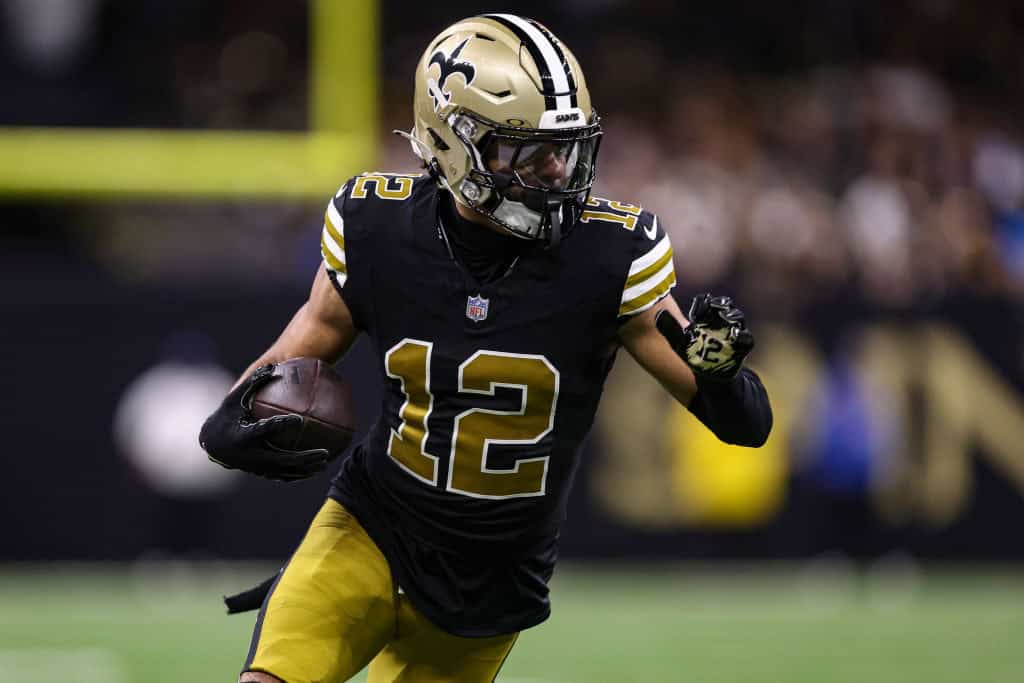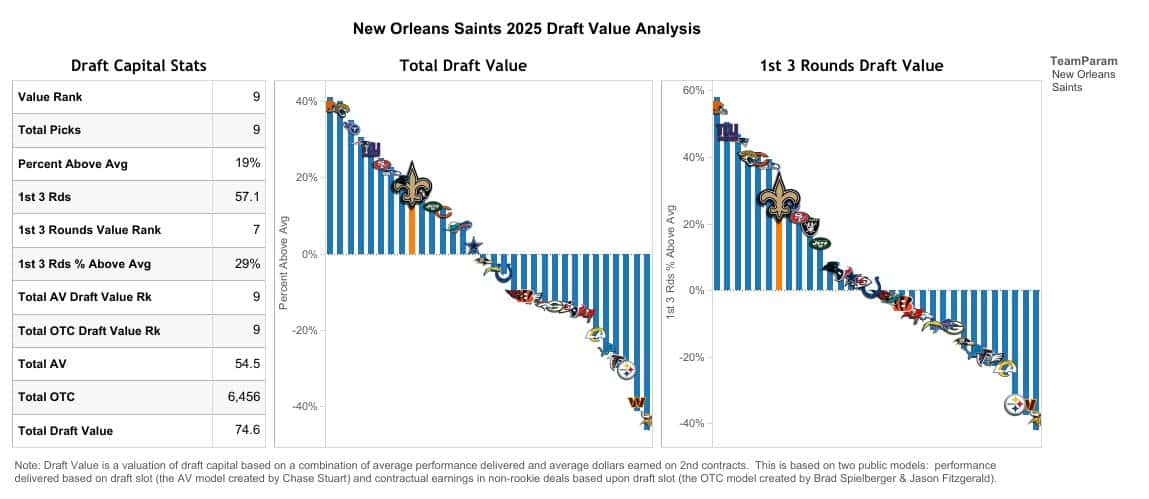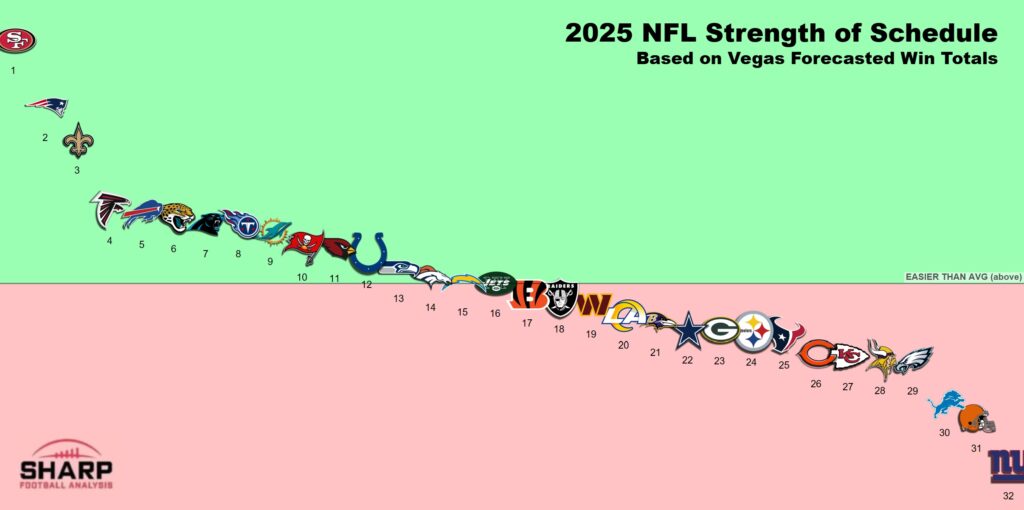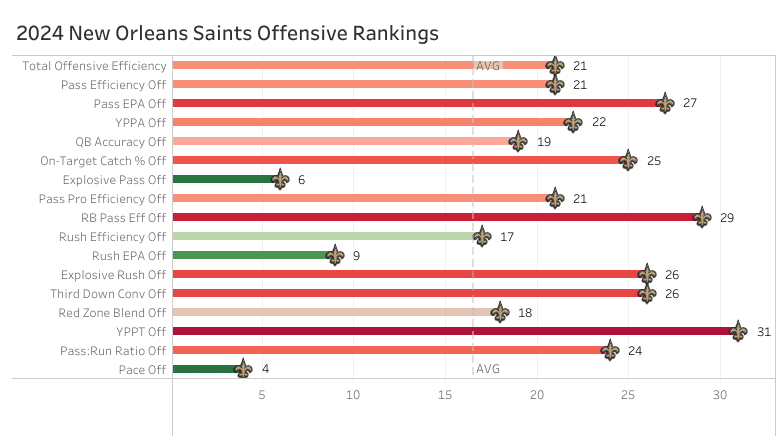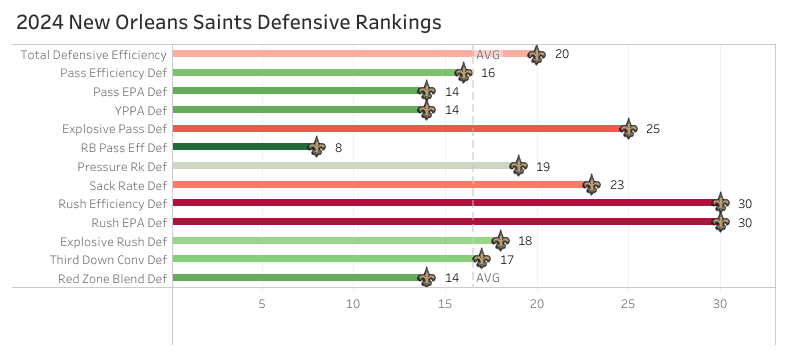As a lead-up to the 2025 NFL draft, we've broken down the current depth chart of every NFL team and identified the biggest draft and team needs for the New Orleans Saints.
You can find additional team-by-team draft needs articles and other draft content on our 2025 NFL Draft Hub.
New Orleans Saints Needs: Top Positions of Need in 2025
- Cornerback
- Offensive Line
- Front 7
What Picks Do the New Orleans Saints Have in 2025?
The New Orleans Saints have 9 picks in the 2025 NFL Draft, including:
- Round 1 (9)
- Round 2 (40)
- Round 3 (71)
- Round 3 (93)
- Round 4 (112)
- Round 4 (131)
- Round 6 (184)
- Round 7 (248)
- Round 7 (254)
Preorder The Best Analytical 2025 Football Preview
Don't miss out on Warren Sharp's 500+ page preview of the 2025 NFL season.
The preview is unlike anything you have ever seen, featuring stunning visualizations built with the reader in mind.
This preview shares insights into players, coaches, teams, and philosophies with one goal in mind: to get you prepared for the 2025 NFL season by delivering the smartest information in the fastest, most direct way possible.
Preorder the 2025 Football Preview now!
New Orleans Saints 2025 Draft Capital Stats
The Saints have the 9th-most draft capital according to our Sharp Football Draft Value.
Our Sharp Football Draft Value is a valuation of draft capital based on a combination of average performance delivered and average dollars earned on second contracts.
New Orleans Saints Draft Value vs. Other Teams:
The Saints’ draft value is 19% higher than the league average of all 32 teams.
New Orleans Saints Draft Prediction:
Find out who our top-rated experts expect the Saints to draft:
- Brendan Donahue's 2025 NFL Mock Draft – Complete first round breakdown from the #2 most accurate mock drafter over the last five seasons.
- Ryan McCrystal's 2025 NFL Mock Draft – Complete first round breakdown from the #8 most accurate mock drafter over the last five seasons.
New Orleans Saints Strength of Schedule, 2025
The New Orleans Saints have the 3rd-easiest NFL strength of schedule for the 2025 NFL season.
New Orleans Saints Offense: Depth Chart, Analysis & Draft Needs
Rich Hribar breaks down the offensive depth chart by position for the New Orleans Saints, identifying areas where the team could improve in the upcoming 2025 NFL Draft.
Quarterback Depth Chart, Saints:
- Derek Carr
- Spencer Rattler
- Jake Haener
- Ben DiNucci
Derek Carr played some of his best football last season.
He completed 67.7% of his passes (9th) for 7.7 yards per pass attempt (10th).
He was sacked on only 2.8% of his dropbacks, his lowest rate since 2016.
Carr was 11th last year in EPA per dropback (0.11)
His 5.4% touchdown rate was his best rate since 2015.
He posted his highest rating and best QBR since 2020.
The hope is that new head coach Kellen Moore will do many of the things Klint Kubiak did to help Carr excel last season when he was on the field.
Carr had the highest play-action rate (27.2%) of his career, and a career-high 60.7% of his dropbacks came with pre-snap motion.
Using play action, Carr was third in the NFL with a 126.2 rating, throwing for a league-high 10.8 Y/A.
On plays with motion, he was third with 8.9 Y/A.
But on 91 dropbacks without play-action or motion, Carr averaged a league-low 5.5 Y/A.
The problem was that Carr missed 7 games last season due to oblique and hand injuries.
The Saints averaged 5.8 yards per play on offense with Carr on the field last season compared to 4.6 yards per play with him off.
That is the difference between being ninth in the NFL last season compared to 31st.
Even after removing the opening two weeks, the Saints averaged 5.5 yards per play with Carr on the field after those weeks.
The Saints went 5-5 in Carr’s starts and 0-7 without him.
Despite playing well last year, we (and the Saints) know that they are not winning the Super Bowl with Carr.
He is the type of quarterback who is good enough to keep you from bottoming out but not quite good enough to prevent you from wanting to upgrade.
The Saints can save money if they move on from Carr after the season, since all his remaining guaranteed money is this year.
Despite his $69.2 million cap hit in 2026, if the Saints cut ties outright, they would save $9.5 million in cap space.
On top of potentially selecting a replacement for Carr, the backup quarterback situation was horrible last season.
It is fair to say that the team was so depleted on offense for the bulk of time that Spencer Rattler or Jake Haener saw the field to give each somewhat of a pass, but neither did anything noteworthy in 2024.
Rattler completed 57% of his passes for 5.8 yards per attempt, throwing 4 touchdowns on 228 passes (1.8%) with 5 interceptions (2.2%).
He was also sacked on 8.8% of his dropbacks.
Haener was 18 of 39 (46.2%) for 226 yards (5.8 Y/A) with 1 touchdown and 1 interception on his limited sample.
Running Back Depth Chart, Saints:
- Alvin Kamara
- Kendre Miller
- Clyde Edwards-Helaire
- Jordan Mims
- Velus Jones
- Xazavian Valladay
Alvin Kamara had a bounce-back season in 2024.
He set career highs in touches (296) and rushing yards (950), posting 1,493 total yards (his most since 2020) while scoring 8 touchdowns (his most since 2021).
He led all backs in receptions (4.9) and receiving yards per game (38.8).
He finished sixth among running backs with 106.6 total yards per game.
Kamara has lost some of his early-career juice and tackle-breaking ability, but he is still an effective dual-purpose back.
He will turn 30 this July, with two years remaining on his current contract.
This is not a team “need,” but New Orleans should look for additional insurance behind Kamara because he has not played an entire season since 2017 and has missed multiple games in the past four seasons.
We have already seen them potentially connected to Ashton Jeanty with their top pick.
Non-Kamara backs on the Saints last year averaged only 3.6 yards per rush with a 35.7% success rate.
Through two seasons, Kendre Miller has managed 80 rushes for 304 yards (3.8 YPC).
When Kamara missed time to close last season, Miller did not capitalize.
If you are looking for excuses, the New Orleans offense was injured and in the gutter at that stage of the season, but Miller could not shelve players like Jordan Mims, who were cutting into his reps.
Miller's rookie contract has two seasons remaining, and he is the only running back on the roster outside of Kamara who is signed beyond this season.
Adding a running back is not an outright necessity, but given Kamara's age, missed time in recent seasons, and the depth's lack of production, it would not be a surprise to see New Orleans add competition here.
Wide Receiver Depth Chart, Saints:
- Chris Olave
- Rashid Shaheed
- Brandin Cooks
- Cedrick Wilson
- Dante Pettis
- Bub Means
- Mason Tipton
- Kevin Austin
This wide receiver room was bludgeoned in 2024.
Chris Olave played in only 8 games due to concussions.
He suffered his first concussion in Week 6 and another in Week 9, which sidelined him for the rest of the season.
While on the field, Olave converted a career-high 72.7% of his targets with a career-best 9.1 yards per target.
Olave averaged 2.15 yards per route (23rd) and has been over 2.0 yards per route in all three seasons in the league.
Olave has not made a complete leap to dominant WR1, but he has been plenty productive on the field, and the Saints will indeed exercise the fifth-year option available this offseason.
Under Kellen Moore, I would bet Olave will get an extra opportunity to play from the slot at a higher rate this upcoming season.
With New Orleans playing a lot of 2WR sets under Klint Kubiak, Olave played a career-low 21.1% of his snaps in the slot last season after 32.5% as a rookie and 38% in 2023.
Moore inherently plays more 11 personnel and moves around his lead receiver.
To this point in his career, Olave has averaged 2.23 yards per route from the slot with a target on 27.9% of those routes.
Lined up wide, he has been targeted on 24.9% of his routes with 2.21 yards per route.
Rashid Shaheed was finally getting his opportunity as a full-time wide receiver and was on his way to a breakout season.
Through six games, Shaheed had 20 receptions for 349 yards (17.5 yards per catch) and 3 touchdowns.
He had at least 73 yards receiving in all but one of his opening five games played with Derek Carr under center.
Even factoring in a Week 6 game without Carr on the field (when he caught 1 of 7 targets for only 11 yards), Shaheed was averaging 2.07 yards per route, which was WR20 at the time.
He then suffered a knee injury that week, forcing him to miss the rest of the season.
Shaheed has been a big-play magnet to start his career.
He has averaged 16.6 yards per catch on 94 receptions over the past three seasons.
Shaheed is set to become an unrestricted free agent after this season.
The Saints are once again cash-strapped and will have to look to extend both Olave and Shaheed, which complicates things.
Outside of adding contractual depth to this portion of the roster, with both Olave and Shaheed sidelined, the lack of depth at the position was exposed a year ago.
With both Olave and Shaheed missing so much, the top players in New Orleans in receptions last season were Kamara (68), Juwan Johnson (50), and Foster Moreau (32).
Cedrick Wilson was the next closest receiver on the roster with 20 catches.
The team brought back Brandin Cooks this offseason as veteran insurance.
Cooks will turn 32 in September. He is coming off a season in Dallas in which he averaged 2.6 receptions for 25.9 yards per game.
His yardage per game has dropped from the year prior in four straight seasons.
The team selected Bub Means in the fifth Round last season, but an ankle injury cut short his season in Week 8.
Tight End Depth Chart, Saints:
- Juwan Johnson
- Taysom Hill
- Foster Moreau
- Jack Stoll
- Dallin Hooker
- Michael Jacobson
- Treyton Welch
New Orleans re-signed Juwan Johnson to a three-year deal this offseason.
Johnson ended the season second on the team in targets (66) and receptions (50) while leading the team with 548 yards due to all of the injuries at wide receiver.
Johnson has increased his receptions per game each year through five years in the league.
The team still has Foster Moreau signed for this season.
Moreau caught 32 passes for 413 yards and 5 touchdowns last season.
Taysom Hill is still under contract for 2025 and is due $17.9 million.
He will turn 35 this August and will be coming back from an ACL injury that ended his season in Week 13.
He had surgery just before the start of the new year, which has put his availability to open the season in question.
Hill was once again a Swiss Army Knife when he was available last season.
Over 8 games, he rushed 4.9 times for 34.8 yards per game with 6 touchdowns, caught 23 of 31 targets for 187 yards, and completed 2 of 4 passes for 21 yards.
His hallmark moment came in Week 11 against the Browns when he rushed 7 times for 138 yards and 3 touchdowns, caught 8 of 10 targets for 50 yards, went 1 of 2 passing, and even had a 42-yard kickoff return.
Offensive Line Depth Chart, Saints:
LT: Taliese Fuaga, Josh Ball
LG: Nick Saldiveri, Dillon Radunz, Brandon Young
C: Erik McCoy, Will Clapp
RG: Cesar Ruiz, Kyle Hergel
RT: Trevor Penning, Josiah Ezirim
The Saints were ravaged by injuries on offense last season, and the offensive line was no exception.
The projected starting lineup for the Saints last season played together in full for 20.3% of the offensive snaps, 30th in the league.
Cesar Ruiz missed four games.
Erik McCoy missed 10 games.
Lucas Patrick missed seven games.
When the team had both Ruiz and McCoy on the field together last season (271 plays), they averaged 6.1 yards per play.
Alvin Kamara had a 43.7% success rate and ran for 10 or more yards on 14.1% of his runs with both players on the field.
He had a 36.9% success rate with both off the field and a 9.6% explosive run rate.
Both Ruiz and McCoy are signed through 2027, but the rest of this unit is still a work in progress.
The Saints selected Taliese Fuaga 14th overall last season.
Fuaga did play in all 17 games, taking all but 6 snaps at left tackle.
Thrown to the fire in his rookie season, Fuaga allowed a 5.9% pressure rate (55th among tackles) with 6 sacks and 10 penalties.
His role is safe moving into 2025, with the team looking for him to take a step forward.
The Saints may not hold their breath in that regard considering their last first-round tackle did not develop.
Trevor Penning moved to right tackle last season and took every snap there.
Moving over to a new position did not help Penning in pass protection.
He allowed an 8.1% pressure rate (85th) with 13 penalties.
The Saints can pick up Penning’s fifth-year option this offseason, but that feels like an unlikely outcome.
With no additions, the left guard position is shaping up to be a competition between Nick Saldiveri and the newly signed Dillon Radunz.
Saldiveri made six starts for the Saints last season, ranking 62nd in overall grade among guards, according to Pro Football Focus.
He allowed a 6.9% pressure rate, which was 84th among guards.
Radunz was only four spots higher in overall grade per PFF.
New Orleans Saints Defense: Depth Chart, Analysis & Draft Needs
Raymond Summerlin breaks down the defensive depth chart by position for the New Orleans Saints, identifying areas where the team could improve in the upcoming 2025 NFL Draft.
Defensive Line Depth Chart, Saints:
- Bryan Bresee
- Davon Godchaux
- Khalen Saunders
- Jonah Williams
- Nathan Shepherd
- Khristian Boyd
- John Ridgeway III
- Ryder Anderson
Once one of the more imposing run defenses in the league, the Saints continued their fall off in 2024, allowing 4.8 yards per carry on running back runs (29th) and 1.78 yards before contact per carry on those attempts (30th).
2023 first-round pick Bryan Bresee has yet to live up to that promise, though he did lead the team with 7.5 sacks in 2024.
His 8.6% pressure rate ranked 84th among qualified players, but it is promising he put together some production.
Still, the Saints will want to see more under new DC Brandon Staley.
New Orleans traded for Davon Godchaux, and they likely hope to get something resembling starting-quality options for their expected new three-man front looks out of the combination of Godchaux, Khalen Saunders, Jonah Williams, and Nathan Shepherd.
Perhaps they can, but this looks more like a group of replacement-level players than real difference makers.
EDGE Depth Chart, Saints:
- Chase Young
- Carl Granderson
- Cameron Jordan
- Isaiah Foskey
New Orleans ranked 18th both in pressure rate (33.6%) and sacks (39) last season.
The Saints did their cap magic again to bring back Chase Young on a three-year deal in free agency.
Young only managed 5.5 sacks in 2024, but his 14.6% pressure rate ranked 14th among qualified pass rushers.
Carl Granderson matched Young with 5.5 sacks of his own, and his 12.6% pressure rate was a solid 38th among that same group of pass rushers.
Long-time stalwart Cameron Jordan played fewer snaps than those two, getting 4 sacks and logging an 8.5% pressure rate on 328 pass rushes.
It will be interesting to see if he gets more looks as something resembling a five-tech under new DC Brandon Staley.
The Saints are likely good with those three in the short term, though depth is a concern depending on where they want to play Jonah Williams, and a new defensive scheme could mess with the usage patterns.
In the long term, though, Jordan is nearing the end of his career and is out of contract after this season.
A depth addition with an eye toward the future makes a lot of sense.
Linebacker Depth Chart, Saints:
- Demario Davis
- Pete Werner
- Nephi Sewell
- D’Marco Jackson
- Jaylan Ford
- Anfernee Orji
- Isaiah Stalbird
Speaking of players who have been in New Orleans a long time, Demario Davis is back for his eighth season with the Saints and 14th season overall.
He continued to play at a solid level last season, leading the Saints with 12 run stuffs and ranking 23rd among qualified linebackers with a tackle on 20.3% of his run defense snaps.
Davis was also ninth among qualified linebackers in yards allowed per coverage snap.
He is out of contract after this year, and the Saints will at some point have to plan for the future, but Davis has not shown many signs of slowing down despite missing his first game due to injury in his whole career last season.
Pete Werner was the primary option next to Davis last season, and he actually bettered the veteran in coverage, finishing third among qualified linebackers in yards per coverage snaps allowed while allowing just 6.4 yards per target in his coverage.
Like on the edge, the Saints are probably good here in the short term, but a developmental depth addition would be welcome.
Cornerback Depth Chart, Saints:
- Kool-Aid McKinstry
- Alontae Taylor
- Isaac Yiadom
- Ugo Amadi
- Rejzohn Wright
- Rico Payton
- Travion Fluellen
The Saints finished 23rd in yards per attempt allowed last season (7.3) and 25th in explosive pass rate allowed (8.9%), but they did rank second in touchdown rate allowed (3.2%).
This secondary has seen a massive shake up with Marshon Lattimore traded midway through last season and Paulson Adebo leaving in free agency.
A second-round pick last year, Kool–Aid McKinstry had a solid enough showing as a rookie, allowing 7.3 yards per target and an 89 quarterback rating in coverage in 15 games.
He should be a primary starter moving forward.
The same is true of Alontae Taylor, who played great in the slot early last season before struggling more when forced to the outside midway through the year.
The new coaching staff should focus on getting him back to the slot this season.
That leaves open a starting spot on the outside, and the front runner for that spot is likely Isaac Yiadom, who re-joined the team after one season with the 49ers.
Yiadom has never been a full-time starter, though, and Ugo Amadi had a tough go during his snaps last season.
A quality option on the outside would be a welcome addition.
Safety Depth Chart, Saints:
- Justin Reid
- Tyrann Mathieu
- Jordan Howden
- J.T. Gray
- Millard Bradford
The Saints leaned into veteran defenders at safety, adding Justin Reid to start next to Tyrann Mathieu on the back end.
That pair never played together in Kansas City, but they should work well together as versatile options who can line up in several different places in the formation.
A 2023 fifth-round pick, Jordan Howden is a solid No. 3 option who finished 14th among qualifying safeties in yards allowed per coverage snap last season.
Perhaps they could use some more depth, but the Saints are in a good spot at safety.


